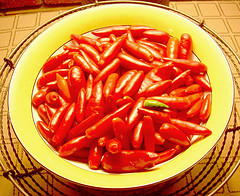The Hot Peppers: How Much Heat Can You Handle?


In this webpage you will learn all about the hot pepper,
otherwise known as the chili, chile, or chilli pepper.

Before I start, I want to first define the hot pepper and its Latin name Capsicum for you.
A hot pepper is defined as the pungent fruit of any of several varieties of Capsicum annuum or C. frutescens.
Very similarly, Capsicum is defined as any various tropical American pepper plant of the genus Capsicum, especially any of the numerous cultivated forms of the species Capsicum annuum and Capsicum frutescens. Capsicum can also be defined as the fruit of any of these plants, especially the dried pungent types used as a condiment and in medicine.
Almost everyone has tried a pepper at some time in their lives, but have you ever wondered what makes them so hot?
The secret ingredient in hot peppers is capsaicin! Capsaicin (cap-say-a-sin) is the culprit to all of the eye-watering, fire-breathing pain.
Like many things, you can build up a tolerance to
capsaicin. Studies show that eating a hot p epper
a day can really keep the doctor away. So much for that old wives'
tale, something about an apple...
epper
a day can really keep the doctor away. So much for that old wives'
tale, something about an apple...
Hot peppers are featured heavily in Native American cultures for medicinal uses. They are also featured in modern medicine, mainly used as topical treatments for increasing circulation and as a painkiller.
A large amount of medical benefits are attributed to eating hot peppers on a regular basis! There will be much more of this to come, but to start off, lets take a look at the classification of the hot pepper!
Website Author: John Shook University of Wisconsin- La Crosse, Organismal Biology, Last updated April 15, 2011
